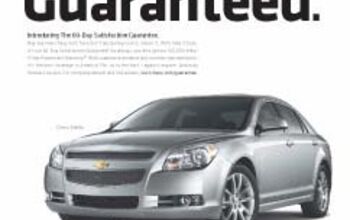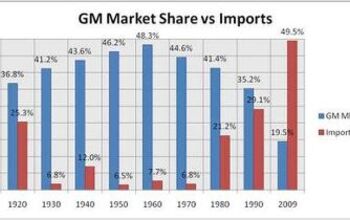The Truth About GM's Hybrids

GM’s decline began fifty years ago, when the domestic automaker failed to repel import sales with competitive products. GM’s rear-engined air-cooled Corvair provided the template: technically advanced, but too expensive to provide profit. A string of over-ambitious and ultimately doomed imports fighters followed: aluminum-engined Vega, the Wankel, X-Body FWD, Olds Diesel V8, Cadillac V8-6-4 and EV-1. Now, when it can least afford a costly mistake, GM is launching a blitz of four different hybrid systems in a desperate attempt to counter Toyota’s successful Hybrid Synergy Drive (HSD). Is GM’s Volt the Corvair reincarnated?
Toyota’s ascendancy has been well documented: the tortoise approach to continuously improved products, processes and technologies. The Prius was born in the early nineties when oil was $15 a barrel. Initially subsidized by Toyota, the Prius is now a profitable product. And Toyota continues to relentlessly wring-out the costs of HSD; the Japanese automaker expects its hybrids to have the same (high) profit margins as its conventional cars by 2010.
Instead of figuring out how to make its (conventional) small cars profitably, GM has opened the floodgates to hybrid development. In fall ’06, Saturn introduced the belt-assist (BAS) or “mild hybrid” Saturn Vue. While GM’s BAS system allowed the domestic automaker to crow that it was, finally, in the hybrid business, sales are… unknown. [GM is the only automaker that doesn’t to break out hybrid sales numbers.]
The two-mode hybrid system set to be introduced on the Chevrolet Tahoe and GMC Yukon is classic GM: a technically ambitious product that costs too much money. GM has publicly stated that the two-mode costs the company $10k. Try amortizing that with three dollar gas; it just doesn’t pan out. No surprise that development partners Daimler and BMW are quietly walking away from the two-mode in favor of their own cheaper partial-hybrid systems. Even using six bucks a gallon gas, Europeans can’t justify the extra investment.
GM will sell a few thousand hybrid Tahoes and Suburbans to politicians, celebrities and the like, so they can ride in their behemoths “guilt free.” Meanwhile, GM is rushing their new light-truck diesel to market. The oil burner’s a better and cheaper choice for the real world conditions in which pickups and SUV’s operate (highway mileage improvement of the hybrid Tahoe is all of 2 mpg). And just who’s going to buy a Chevrolet Malibu with a $10k two-mode hybrid system?
Now, “plug-in hybrids” have replaced the fuel cell as the eco-darling concept du jour. GM has no fewer than two such systems in development. A plug-in version of the Vue could well end up costing $45k ($6 to $10k on top of the $10k cost of the two-mode system).
And then there’s the Volt. According to GM’s Bob Lutz, “Five years from now there will be one technology leader in the world, and it will be GM.” That boast has a familiar ring to it. And even if it turns out to be true, it will be a hollow (i.e. unprofitable) victory.
GM is sending its series-hybrid Volt to a showdown at the ECO corral against the parallel-hybrid Prius. With its projected 40 miles plug-in range and on-board generator, the Volt sounds impressive. But the Gen3 Prius due out in 2010 (like the Volt?), may well equal and even eclipse the Volt’s efficiency.
The Volt’s weakness– intrinsic drive train inefficiencies– show up as soon as its battery range is exhausted. While GM projects 50mpg during “charge sustaining operation” operation, that’s a misleading claim. The batteries will need to be charged by the generator– as well as keeping the car moving. Like all electric vehicles, the Volt will do best in shorter-range city driving.
The Prius’ HSD drive feeds the output of its gas engine directly to the wheels at higher speeds. It’s an intrinsically more efficient solution than using a generator to send power to an electric motor via the batteries. And Gen3 Prius will easily meet or exceed the Volt’s 50mpg continuous-use projection; Toyota projects a 15 to 20 percent improvement over the Prius’ current 46mpg EPA rating. Gen3 Prius will also have expanded electric-only range, as well as an optional plug-in range extender, approaching the Volt’s electric-only range.
GM will milk all the publicity it can get from the Volt. Hard-core eco-poseurs will buy in. After spending a billion dollars developing the Volt, they’re looking to sell some 60k annually at $30k apiece. GM is anxious about that price, and is already floating the idea of renting the battery pack separately from the car (negating any actual savings from plug-in electric energy) to try to blunt the impact (“We’ll sell you a Volt for $20k, battery not included”).
Meanwhile, Toyota will be selling 150k similarly-efficient Prii for a mere $20k, and making a tidy profit doing so.

More by Paul Niedermeyer
Latest Car Reviews
Read moreLatest Product Reviews
Read moreRecent Comments
- InCogKneeToe Wow, memories. My Parents have a Cabin on a Lake, I have a Plow Truck and Friends, access to Lumps (old tired autos). What happens? Ice Racing!. The only rules were 4 cylinder, RWD only. Many Chevettes were destroyed, My Minty 1975 Acadian Hatch Auto with 62,000kms, did also. Rad, Rad Housing etc. My answer, a 1974 Corolla Hatch 4 speed, the rest of the Vettes took offence and Trashed the Yota. It was so much quicker. So rebuttal, a 1975 Celica GT Notch, 2.2L 20R, 5 Speed. Needed a New Pressure ate but once that was in, I could Lap the Vettes, and they couldn't catch me to Tag me.
- 28-Cars-Later I'm not sure when it was shot, but I noticed most shots featuring a Ford are pushing the BEV models which haven't sold well and financially kicked the wind out of them. Is it possible they still don't get it in Dearborn, despite statements made about hybrids etc.?
- ToolGuy I watched the video. Not sure those are real people.
- ToolGuy "This car does mean a lot to me, so I care more about it going to a good home than I do about the final sale price."• This is exactly what my new vehicle dealership says.
- Redapple2 4 Keys to a Safe, Modern, Prosperous Society1 Cheap Energy2 Meritocracy. The best person gets the job. Regardless.3 Free Speech. Fair and strong press.4 Law and Order. Do a crime. Get punished.One large group is damaging the above 4. The other party holds them as key. You are Iran or Zimbabwe without them.


































Comments
Join the conversation
maybe some one said this but until the usa upgrades its electrical grid -mass plug in cars wont work-theres rolling brown-outs now when it gets hot in Cali,hows it going to keep up with cars charging and ac running in everyones house over night? they will have to build more coal fired power plants or nuke plants and if your going to do that ,ya might as well go hydrogen- or diesel hybrid. ethanol and pure electric cars will hurt the environment as much or more,and raise the price of grain and electricity- which basically raises the price of every thing. only good thing about is we don't have too buy oil from crazy south american, african and middle east governments .
The cars can be charged at night, when there's lots of spare capacity (most places). This doesn't become a problem until *many* electric cars are sold. Have faith in your local electrical utility. They will find a way to make money off you.